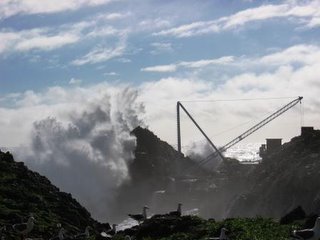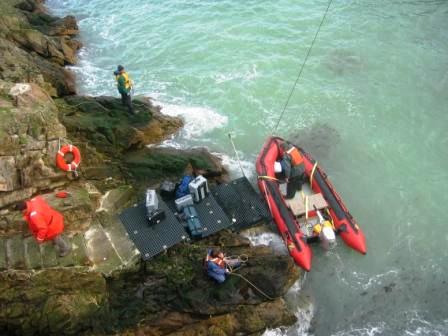Well it’s been a quiet week on Southeast Farallon, our home island, out here on the edge of the continental shelf. With September being one of the slowest on record (we banded 90% fewer birds than average), the crew was a bit downtrodden. We had to take joy in the few birds that were showing up. On Oct. 1 a couple of White-tailed Kites made a lap around the lighthouse, and we discovered one of the Burrowing Owls that was banded in 2007. A5 (the number on its blue color band) has spent the past three winters on the island in the same auklet burrow. The next few days were pretty windy, leaving us with fairly low bird diversity, and even lower spirits.
On Oct. 5 we saw a ray of sunshine with a small increase in diversity, including a couple unusual species. Great Blue Heron, Northern Harrier, Black-bellied Plover, and Varied Thrush all made an appearance. The weather forecast was showing some favorable conditions over the next several days, so we decided to start the Farallonathon. This is an annual event each fall in which we attempt to score points by finding as many species as possible, including marine mammals, fish, salamanders, butterflies, dragonflies, as well as birds, over a seven day period. Farallonathon usually starts sometime in late September with one of the bigger waves that usually come that time of year. As this year is unusual, we waited until October to start.
The next day we garnered a few more points from Minke Whale, Monarch, Black Saddlebags, Mew Gull, Short-eared Owl, Barn Swallow, Hermit Warbler, Clay-colored Sparrow, and White-throated Sparrow, among others. We were literally scrounging for points on the 7th as the winds continued to come from the WNW with Mark looking around for Arboreal Salamanders (he found one). A rush of excitement came in the afternoon when Matt flushed a nightjar, which we then chased for an hour up and down Lighthouse Hill. This cryptically colored group of birds can be very difficult to identify when seen. The calls of these birds are the easiest way to identify them, which they usually give at night. After several fleeting glimpses of the bird and discussion of the features each of us had seen, we came to the conclusion that the bird was a Common Poorwill. With less than 10 records for the island, it's a rare bird for us even though they are relatively “common” along the mainland coast.



Light winds and high overcast greeted us on the morning of Oct. 8 and brought more birds to the island, though not the wave we were hoping for. The new species we saw were mainly migrants from the western US, which still give us Farallonathon points, but don't get us nearly as excited as the vagrants from the east. We added Black-vented Shearwater, Wilson's Snipe, Warbling Vireo, Nashville Warbler, Western Tanager, Grasshopper Sparrow, Lazuli Bunting, and Purple Finch. The one eastern bird we did see was a Rose-breasted Grosbeak. Farallonathon points that day also came from Harbor Porpoise, Hoary Bat, Green Darner, Variegated Meadowhawk, and a shark attack off of Saddle Rock (those are worth 5 points). So on day 4 of the Farallonathon, we were at 118 points. Last year we ended with 129 points which was the lowest ever. Could we get eleven more points in three days?

No problem when you get hit with a WAVE DAY! The long awaited wave of migrant birds appeared on Oct. 9. The biologists were feeling as light as the south winds and flying as high as the overcast skies. Birds were flitting about everywhere, from the marine terrace to the lighthouse. A flock of 20+ Hermit Thrushes was seen around the top of Lighthouse Hill early in the morning. Yellow-rumped Warblers (both Audubon's and Myrtle) seemed to be covering every square meter of the island. A flock of about 250 Violet-green Swallows was swirling around the island. After getting past the shear numbers of birds, we started to sift through the flocks and pick out some interesting birds. Early on we saw a Chestnut-collared Longspur that arrived at the lighthouse and then made its way down to the terrace, where we were able to get some great pictures. Then a Red-eyed Vireo was found in Twitville. As for warblers we added Tennessee, Blackburnian, Blackpoll, MacGillivray's, American Redstart, and Ovenbird. Bobolink, Least Flycatcher, and Lawrence's Goldfinch were also good finds. A Solitary Vireo was seen that suggested a Blue-headed. With a nice photo by Kristie, we were able to confirm that ID. The big find that day though was a Gray-cheeked Thrush. There have only been 21 records of this species in California, over half of which are from Southeast Farallon Island. This bird was found in a flock of Hermit Thrushes atop Lighthouse Hill and was accommodating enough to allow everyone to see it.


When it was all totaled up in the journal, we had seen 87 migrant bird species and 1332 individual landbirds. We set island high count records for Violet-green Swallow and Audubon's Warbler and saw 16 species of warbler and 16 species of sparrow. With all the new birds and a couple shark attacks, our Farallonathon total shot up to 158. Though our goal of “not being the worst” was pretty low, we crushed it with two days to spare.
With visions of vagrants in our dreams, we went to bed exhausted and elated. What would tomorrow bring? As we starting birding on the 10th it was obvious that there were fewer birds on the island, but there were different birds around. The numbers of Hermit Thrushes and Yellow-rumped Warblers were reduced by two-thirds, and Golden-crowned Kinglets doubled. We found Chestnut-sided, Magnolia, Black-throated Green, Palm, and Black-and-white Warblers. Long-billed Dowitcher, Band-tailed Pigeon, Hammond's Flycatcher, Northern Mockingbird, and Orchard Oriole were also nice additions. To add to the frantic pace of the day, we were also switching crew members and getting our food shipment. Jim, Matt, and Kristie were leaving, and Pete Warzybok and Andrew Greene were arriving.




About an hour before Jim was supposed to get on the boat and leave, he and Pete came across a bird that Jim didn't recognize. That's code for “it's probably not from North America.” He called out on the radio that he had just seen an “Asian bunting,” which sent us all running. Unfortunately, the two minutes it took for others to get to Jim were just long enough for the bird to disappear. It wasn't seen again. Jim consulted a field guide and identified the bird as a Yellow-breasted Bunting. The only records for this species in North America are from Alaska, and there are only a few. It has never been seen in the lower 48. Super mega, mega rarity. Then Jim left, and the bird was never refound. The other biologists were left in a state of shock. Such an amazing bird, that we didn't get to see, even on this tiny, barren island. What other birds have we missed? No sense in dwelling on it though. Ten Farallonathon points anyway.
Sunday, Oct. 11 was the last day of Farallonathon, and we were determined to squeeze out some more points. Diversity and numbers were down, but new species were still being found. A few of the highlights were Northern Shoveler, Tropical Kingbird, “Siberian” American Pipit, Black-throated Blue Warbler, Lark Bunting, and Yellow-headed Blackbird. Interesting fact for the day was that we saw all three Black-throated warbler species (Blue, Gray, and Green). Our Farallonathon point total was 193, which was the sixth highest total since it started in 1992. Hooray for wave days!


The following week saw a big change in the weather, as we were slammed by a storm on the 13th. We'll try to post some pictures of that soon. As would be expected, the numbers and diversity of birds are down. We had a flock of blackbirds that included Brewer's, Red-winged, Yellow-headed, and Tricolored Blackbirds with a few Brown-headed Cowbirds. That's a nice icterid flock. A Virginia Rail was found (and banded) on Oct. 12, followed by a Sora (also banded) on Oct. 16.
That's the news from Southeast Farallon Island, where all the biologists are strong, all the Elephant Seals are good looking, and all the vagrant birds are above average.







































